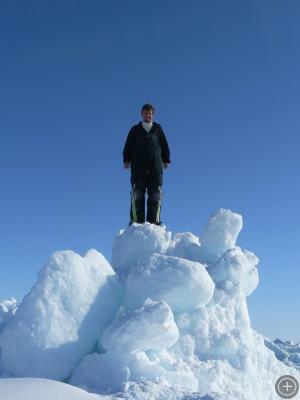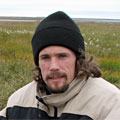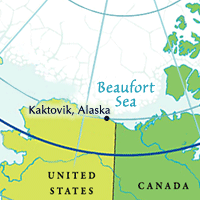Back in the Air
KAKTOVIK, ALASKA– On April 8th, I woke up at 315am, caught a shuttle to the Denver airport, and boarded a plane for Seattle. After additional layovers in Anchorage and Deadhorse (Prudhoe Bay), I landed in Barrow, Alaska, at about 530pm. It was around -5 degrees (Fahrenheit) with a light wind. I had envisioned a return to wintry conditions, but it was still a shock to go from the humid heat of Buenos Aires in the summer, to early spring in Wyoming, to late winter in the Arctic.
I met up with the team of researchers from the US Geological Survey who had been performing polar bear captures out of Barrow already for two weeks. That evening, after looking over our gear and getting caught up, I went over to see friends who recently moved to Barrow from Wyoming. It was great to hear about their new life in the area; moving from the mountains to the tundra is certainly a big change.
The next day I began flying in the helicopter for captures. We started in Barrow, fueled up in Deadhorse, and ended the day in Kaktovik, near the Canadian border – we covered almost the entire northern coast of Alaska. Since then we have been based out of Kaktovik, and we have had good weather and have been flying a lot.

It is great to be back out on the sea ice. Although I am out of place here, I really love this environment. In this picture we landed on a small pan of ice about twenty miles from shore; the pan was surrounded by pressure ridges and rubble from ice sheets smashing into each other.
The captures have been going well. We caught the largest bear I have seen, an adult male who weighed 1,147 lbs (I am not sure what the largest bear caught in the southern Beaufort has weighed). His neck was several times the size of my waist, and I could not fit both hands around his snout. It took several people to position him for measurements. We have caught several bears which were sampled in 2009, giving us excellent data on changes over time in the same individual.

We have also caught a lot of cubs-of-the-year, or COYs, including this litter of three. Cubs are born around January 1st. Litters of three are fairly uncommon for polar bears in Alaska, and usually include one cub that is noticeably smaller than the others – in this picture, the cub in the middle only weighed 12 lbs, nearly 10 lbs less than the other two.











Greetings,
I greatly appreciate the work you are doing with the scientific community to demonstrate climate change in a very fragile ecosystem.
Very respectfully,
David Merian